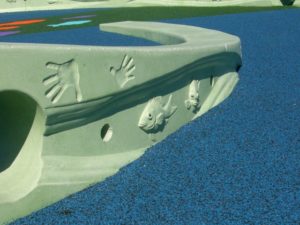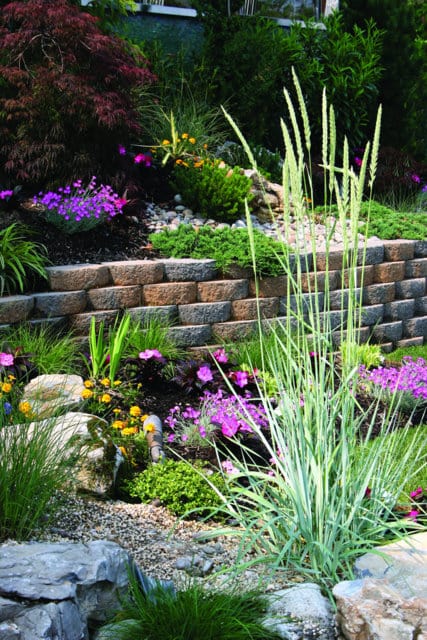
These are some of the commonly asked questions about colored concrete. If your question isn’t answered here, please send your question to us at info@daviscolors.com. We would also like to hear from all you Contractors or Operators who might have a better answer than us!
Does concrete colored with Davis Colors fade?
The color can’t fade, but the concrete can. The active ingredient in every Davis product is pure inorganic pigment which is made in a process of oxidizing metal, in essence, “fading” metal into a pigment powder. The resulting powder pigment concentrate is impossible to fade. That’s why it’s the same active ingredient in another permanent coloring application: tattoos. Concrete, on the other hand does change with time and weather exposure. Even uncolored concrete which turns yellow, erodes and darkens as it accumulates dirt, dust and grime from the environment. Left unprotected or weakened by a poor mix design or finishing job, the surface of concrete “dusts” and erodes slowly until fine aggregate and sand particles are exposed. This same process occurs in colored concrete. The solution is to buy concrete from a supplier who offers mixes designed for durability and an installer with experience in finishing “architectural” concrete. Then keep colored concrete fresh looking by protecting it with periodic applications of a good clear sealer.
Where can I get colored concrete?
If you’re a homeowner, the best place to start is with the yellow pages or a local newspaper. Look for Concrete contractors, Landscape contractors or call your local Ready-Mix concrete supplier and ask for the name of a good concrete contractor. If you’re an architect, just specify the Davis Color you want in plans or specifications. In the future, you can find suppliers and installers in our Concrete Mart here, in our web-site. It’s new and we’re just starting to post the names of installers and suppliers.
The easiest way to find a color supplier for concrete is to use our supplier locator. To find a qualified contractor contact your local Ready-Mix concrete supplier and ask for the name of a good concrete contractor. If you’re an architect, just specify the Davis Color you want in your plans or specifications.
How much does color add to concrete cost?
Approximately 10 to 30% to the cost of the concrete itself. But it only adds a fraction to the total installed cost, since most colored concrete is mixed and finished in the same way as uncolored concrete. The answer depends on the color you choose and whether you take advantage of all the fancy finishes and textures that skilled contractors are capable of.
 I was told to occasionally sprinkle water on my fresh colored concrete. Is that OK?
I was told to occasionally sprinkle water on my fresh colored concrete. Is that OK?
NO. Sprinkling water on fresh concrete is a common way of curing uncolored concrete. The problem is it can lighten or whiten the concrete and that looks bad on colored concrete. If you have hard water, sprinkling it on the concrete can also cause a lot of efflorescence (white salt deposits) to form which also looks bad on colored concrete. The best way to cure colored concrete is with an application of W-1000 Clear™ cure and seal. Some contractors will try other companies cure sealers. Some solvent-base sealers work well, but most water-based sealers don’t work. They may also turn white or could yellow with sun exposure. Only the manufacturer of the sealer can say for sure. If you don’t want to use the W-1000 and the weather is mild, ambient temperatures in the 60’s to 70’s and humid, just leave the fresh concrete to cure without adding anything.
Do I need to apply a sealer?
Not necessarily. Colored concrete will get good and hard just like normal concrete. However, all concrete benefits from being sealed against stains and water damage. So even though it’s not necessary, sealing your colored concrete will make it look good longer and will help prevent dusting of the surface.
My new colored concrete is much darker than your color card. Why is that?
Fresh concrete is always much darker than when it is fully cured and dry. Even uncolored concrete. Wait at least 7 to 10 days until the new concrete has hardened and dried. If the concrete is on a wet subgrade or there’s underground water, it may stay dark for as long as it’s wet.
My colored concrete has some areas where it’s much darker than other spots. Why?
If the concrete is new, that is less than two weeks old, it could still be drying. However, if some of the dark spots seem to be staying dark while the rest of the concrete is drying out, you may have areas of “Entrapped Moisture”. Entrapped moisture is a condition that appears as random dark areas which can be completely different in shade from unaffected areas. It may also precisely follow areas that were “hard troweled” or where edging and jointing tools were used. Remedy entrapped moisture by scrubbing the dark spots with a stiff bristle brush and flushing with water. Repeat the process over a few days and they should lighten up. If your concrete is older than two weeks, wet the dark spots with water, then pour on some white vinegar and scrub with the stiff brush. Entrapped moisture takes a few treatments to disappear. Check out our Contractor’s Guide to see how to avoid entrapped moisture in the first place.
Can you guarantee the color will match the color card?
Unfortunately, Not. The final color is a function of the cement color, sand color, the amount of water used as well as finishing methods. We only guarantee that our color additives will match our standard, that is, they will be the same from batch-to-batch and year-to-year.

